Vision in echolocating bats - Fladdermus.net
Vision in echolocating bats - Fladdermus.net
Vision in echolocating bats - Fladdermus.net
You also want an ePaper? Increase the reach of your titles
YUMPU automatically turns print PDFs into web optimized ePapers that Google loves.
comb<strong>in</strong>ed with broadband echolocation. In fact, most bat-poll<strong>in</strong>ated<br />
plants are greenish, p<strong>in</strong>k and white, which presumably reflect the fact that<br />
<strong>bats</strong> are most likely colour-bl<strong>in</strong>d (Suthers 1970; Faegri & van der Pijl<br />
1979). On the contrary, many species of bat poll<strong>in</strong>ated Parkia<br />
(Legum<strong>in</strong>osae: Mimosoideae) have bright red and yellow colours<br />
(Hopk<strong>in</strong>s 1984). It is also suggested that dark flowers can be seen as<br />
silhouettes, aga<strong>in</strong>st the sky and that pale flowers appear conspicuous<br />
aga<strong>in</strong>st dark foliage (Start 1974, cited <strong>in</strong> Hopk<strong>in</strong>s 1984). If the <strong>bats</strong> make<br />
use of such differences <strong>in</strong> contrast, one would expect to f<strong>in</strong>d that the<br />
position of differently coloured flowers vary accord<strong>in</strong>gly <strong>in</strong> relation to the<br />
foliage, i.e., red flowers far from foliage and yellow flowers closer, which<br />
<strong>in</strong> fact, seems to be the case.<br />
The capitula of Parkia are also highly reflective under<br />
moonlight and starlight conditions, and are therefore presumably visible<br />
to poll<strong>in</strong>at<strong>in</strong>g <strong>bats</strong> (Hopk<strong>in</strong>s 1984). Many poll<strong>in</strong>ators make use of a broad<br />
spectrum reflected from flowers, fruits or seeds, <strong>in</strong>clud<strong>in</strong>g ultraviolet<br />
(UV) light (for example <strong>in</strong>sects, Kevan et al. 2001; and birds, Church et<br />
al. 2001). Ultraviolet vision seems, however, to be absent <strong>in</strong> most<br />
mammals, although some rodents have been shown to have UV sensitive<br />
ret<strong>in</strong>as (Jacobs et al. 1991). Recently, it was suggested that <strong>bats</strong> might<br />
perceive UV-light, as there is evidence for a spectral sensitivity peak<br />
around 390 nm (i.e. <strong>in</strong> the near UV-range) <strong>in</strong> the nectarivorous<br />
Glossophaga soric<strong>in</strong>a (Lopez et al. 2001). However, if the <strong>bats</strong> actually<br />
use UV reflect<strong>in</strong>g surfaces as orient<strong>in</strong>g cues is still uncerta<strong>in</strong>, although<br />
Willson and Whelan (1989) have shown that UV-reflectance is <strong>in</strong>deed<br />
relatively common throughout the plant k<strong>in</strong>gdom. The Passiflora species,<br />
Passiflora galbana and Passiflora mucronata, two plants which flowers<br />
are exploited by the nectarivorous glossophag<strong>in</strong>ae <strong>bats</strong>, reflect light down<br />
to ca 400 nm and 370 nm (upper UV range), respectively. This should be<br />
compared to the humm<strong>in</strong>gbird poll<strong>in</strong>ated Passiflora speciosa, which has<br />
its ma<strong>in</strong> reflection above 570 nm (Varass<strong>in</strong> et al. 2001), perhaps<br />
reflect<strong>in</strong>g the spectral sensitivity of the poll<strong>in</strong>ators. Furthermore, 80% of<br />
nocturnal Lepidoptera have w<strong>in</strong>g patterns that reflect UV, compared to ca<br />
30% <strong>in</strong> diurnal species (Lyyt<strong>in</strong>en 2001 cited <strong>in</strong> Honkavaara et al. 2002).<br />
On the other hand, this may imply that <strong>bats</strong> cannot make use of the<br />
ultraviolet light, <strong>in</strong> contrast to birds, which usually forage <strong>in</strong> daylight.<br />
32


